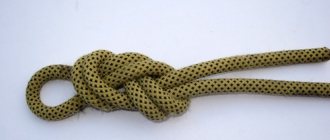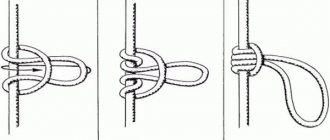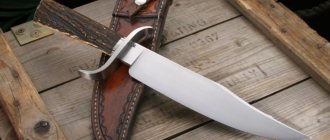Knots and how to tie them – it would seem that what’s so complicated about this? After all, we encounter them in everyday life at every step and tie them without even thinking. From early childhood we were taught to tie shoelaces, girls were taught ribbons and bows, then men learned to tie a tie. And then - in everyday life, fishing, on vacation, hunting, in sports or maritime affairs - one way or another, but knots are present everywhere. Let's figure out how to tie knots on a rope correctly and which ones are the strongest.
What are nodes
Knots have existed for a long time; even our distant ancestors used them to create the first tools, clothing, and obtaining food: hunting and fishing. In essence, a knot is a certain way of weaving ropes, fishing line, ribbons, threads and other things, a way to connect them together or tie them to something by creating a loop.
That is, the nodes have a very long and quite rich history of both application and development. After all, in every business, craft, direction where they were used, they came up with their own types, the most convenient, strong or beautiful, depending on priorities. Such a connection can be woven from a different number of ropes, their different lengths, diameters. They differ in areas of application.
How to tie tourist knots correctly? Results
Let's summarize. All types of rope tourist knots can be divided into a number of conditional categories depending on the scope of their application. Let's highlight the main ones:
- for tying two ropes of the same diameter;
- for tying ropes of different diameters;
- to create loops;
- for tying a rope around an object (tree, pole, etc.);
- to grab another rope (attaching a belay, organizing a crossing - will be needed on a tour to Kamchatka).
This is not a complete list of the purposes of rope knots for tourism. However, having mastered the above set of knots, you will become much more efficient and useful in your hiking life. It is important to remember that each knot must be given special attention in order to knit it correctly. After all, not only your life, but also that of your fellow hikers may depend on your attentiveness. Let your ability to tie knots help you keep yourself and others safe.
Which ones exist?
Knots can be sea, tourist, mountaineering, hunting or fishing - this is a difference in the scope of their application. For example, there are about seven hundred sea knots alone!
Certain requirements apply to each type. For example, tourist ones, in addition to the fact that they must be strong and simple: they must be easy to remember, easy to tie, not crawl under load, not tighten tightly if this is not necessary.
Of course, it is hardly possible to know how to tie knots on all types of rope, and it is not necessary. This is not available to any person on the planet. It is enough to simply understand how to tie knots on a rope tightly and so that they look presentable.
Of course, you won’t get a good, strong connection or the right loop right away. You need to learn how to tie a strong knot in a rope through practice, not just theory. Although it is also necessary to know the theoretical basis. For example, how to tie a knot at the end of a rope: fold the free edges into a loop, leaving a tail of the length that the knot is needed, thread it through it, and tighten it. The knot at the end of the rope is ready!
What determines the strength of a knot?
How to tie knots on a rope so that they are strong? The answer to this question is simple: firstly, you need to be able to knit them, no matter how trivial it may sound. And secondly, the rope itself must be strong enough for this, otherwise no matter how much knot tying skills you have, it will be of little use.
Any rope, cord or rope and everything from which knots are tied has its own strength characteristic. Moreover, if a rope is used, for example, to tie a tent to a peg or even a boat to a fishing pier, hardly anyone thinks much about the level of its strength. But in some areas of application of knots such inattention is unforgivable, for example, in mountaineering.
One fact is worth considering: any knot somehow makes the rope less strong, for example:
- the figure-eight knot weakens by a quarter;
- bowline - by a third;
- weaving - by 35%.
All other knots make the rope less strong by about the same amount. Also, for the level of strength of both the rope and the knot, it is worth considering the following:
- if it is wet, then its strength decreases by 10%;
- if used in severe frosts (up to 30 degrees), then it becomes less durable by a third;
- Ropes that are dirty, old, have been in the sun for a lot of time, or with damaged braiding lose half their strength.
Application options
Knots are found even in everyday life at every step, and they can be both functional and simply decorative. For example, recently, bracelets or necklaces made from cords, laces and thin ropes tied in beautiful knots have become especially popular.
They are also used to tie two ropes of the same thickness. In tourism, instead of ropes, other materials of different thicknesses can be used. Using a knot, you can tie a wide variety of loops: tightening, climbing, quick-release (aka bow), bowline, or those that are very difficult to untie. Keep in mind that most knots lead to chafing of the rope and also tend to unravel on their own.
We knit a straight knot
Tying a straight knot is very simple, but it is intended for those cases when someone's life does not depend on it. Those. It is not suitable for belaying, because it can come untied and slide off. When tying a straight knot, so-called control fixing knots are required. What's good about this node? It is easy to untie, just pull the two ends of the rope on one side of the knot. And besides, it knits quickly and easily. Those. If you need to quickly tie two ropes of the same diameter for light loads, a straight knot is perfect.
Direct node diagram:
One of the control node options:
Knot
Probably the most famous of all knots. You may not know how to tie it, but everyone has probably heard about it. What is it and how to tie a sea knot on a rope?
First of all, it must be said that there are several sea knots, and each of them has its own name: running simple, reef, bowline, snare, scaffold. All of them are tightening loops, with the help of which the ship was tied to the pier. Their peculiarity is a certain way of knitting and tightening the rope, in which it is stretched, making the knot reliable. And when the rope is loosened, the noose is easy to untie.
The bowline or arbor knot is most often used. There is nothing difficult in learning how to tie it, and such a skill can come in handy at any time. Tie it as follows:
- a small loop is made, a piece of rope of such length as the size of the knot is needed is left in stock;
- this end is threaded through the loop, as when tying a simple knot;
- wraps around the free end of the rope, threads it through the small one and tightens.
↑ Bowline knot
The next classic knot is
Bowline
. Sometimes it seems to me that if a person knows three sea knots, then among them there will definitely be a straight one, an eight and a bowline. In my opinion, it’s not worth describing how it is knitted for the simple reason that there are a “milion” ways to tie it. But the essence of the knot does not change depending on how you tied it, nor does its work.
The only thing that is significant is how the knot will look in its finished form, and since this knot is most often used for tying oneself, a loved one, when you need to somehow secure yourself, for example, for belaying a rope, I depicted it somewhat unconventional.
In fact, a bowline is a representative of the class of non-tightening loops, and I didn’t draw the loop itself, which goes behind your back; it’s still not visible. But the knot is in the position in which you will look at it when it is ready after you tie it. A little free advice: the loop should be tightened around you as tightly as possible and raised under the very armpits, only in this way it can help if you suddenly have to use it to save your precious skin.
In general, the application of the knot is much wider. It is used wherever it is needed, and almost everywhere it works quite decently, but sometimes it gives back change for incorrect use. As a rule, it consists in the fact that when used under a load exceeding the optimal one for a given diameter of the rope, the bowline refuses to give out. If you fell and the knot saved your life, then the rope is still being scrapped and it’s not such a pity, but if you tied a four on this bowline on a six, that is, there were no jerks, the rope is quite good, then it will be cut It's a shame. But there is nowhere to go; this is the price to pay for the simplicity of the node. Of course, you can save the rope with the help of a nok
- a special wooden or metal rod that is tied into a knot in a special way, but this is a topic for a separate conversation, which I would not like to touch on now.
For tying two ropes
It happens that it is necessary to tie two or even more ropes together, and also add knots to already tied ropes. There are special loops for these purposes. So, how to tie a knot on a tied rope using a Flemish loop or a counter figure eight, which is one of the oldest, strongest and strongest:
- at the end of an untied rope, make a figure eight from its free edge;
- With the remaining end of the knotted one, they repeat the bends and thread them through them, while tightening the loop.
This knot practically does not weaken the strength of the rope, and is easy to untie if necessary.
Untied knot
Sometimes it is necessary to tie a loop that will not come undone under any circumstances. As a rule, these are tightening knots. Weaving is considered one of these. So, how to tie a strong knot on a rope that will definitely not come undone at the most inopportune moment? First of all, you need to understand that it is a combination of two knots, which are tied with running ends around the base:
- lay two ropes with ends facing each other;
- make a simple knot at one end;
- pass the end of the other through the loop made on the first, make a turn around its base;
- tie the same simple knot with the second rope;
- move both loops towards each other until they come together;
- Tighten the knot properly.
This is a very strong knot; for all its apparent simplicity, when pulled, it becomes so strong that it seems unlikely to untie it.
↑ Straight Knot, Reef Knot, Tight Reef Knot
The first of the main nodes will consider the
Direct
. Apart from the figure eight, which we will meet below, this is the only node that does not have a second name. Already the reef one has some other names, I just don’t remember them, but I’ve seen them. The knot is the most famous and, perhaps therefore, one of the most scandalous. The advantage of the knot is its simplicity: two half-knots directed towards each other, which form two mutually penetrating open loops.
Disadvantage: creeps under load, especially on modern synthetic (read: slippery) ropes, or if applied incorrectly.
Purpose: to tighten the two ends of the rope when it is necessary to tighten something, for example, to pull a backpack to the frame, to tie up some kind of bundle. Actually came from here
Reef node
. Its original purpose is to tie part of the sail to reduce the area. The straight sail, like the reef sail, copes with this task exemplarily, but the sails must not only be tied (take reefs), but also quickly released when the wind weakens, so the reef sail, unlike the straight sail, has one more loop, which is clearly visible in the figure . When forming the second half-knot, one of the running ends is simply folded in half, then we get the effect of Grandma Little Red Riding Hood: you pull the string...
But is this always good? Even a twig can pull a string while hiking. Then the following improvement of this unit appeared: we put the running end, which did not participate in the formation of the additional loop, into this very loop. We pull everything together and get a small neat knot. I have not seen this last knot in the literature, so I don’t know its correct name, we call it Tightened Reef
. We use a tightened reef for tying gondolas to the frame, not just one, of course, but in a set with other units, but it is the final one.
Beautiful knot
Of course, not all loops and knots serve exclusively for functional purposes; they are also used to create jewelry: bracelets, necklaces. Knots are also tied simply for good luck, used in macrame techniques, lace making and more.
And this is where knowing how to tie a beautiful knot on a rope comes in handy. But there are quite a lot of such knots, so we’ll tell you about a couple of the easiest and most attractive ones.
Everyone remembers and knows how to braid a pigtail. So, if you intertwine one or more ropes in this way, you get a beautifully tied braid of knots.
Another popular pattern is a woven crown or, using the terminology of the macrame technique, cobra. Used to create textile bracelets, necklaces, baubles, keychains and laces for an umbrella or a dog leash. It is knitted from four ropes as follows:
- connect the ends of the ropes together;
- turn the ends towards you;
- tie a crown knot, making a loop from each rope and pulling the end that lies behind it into it;
- tighten and continue tying knots to the desired length.
The braided crown lace is ready! Now you can close its ends with special caps with a clasp, which can be purchased at a jewelry supply store, and use them as a bracelet or necklace.










